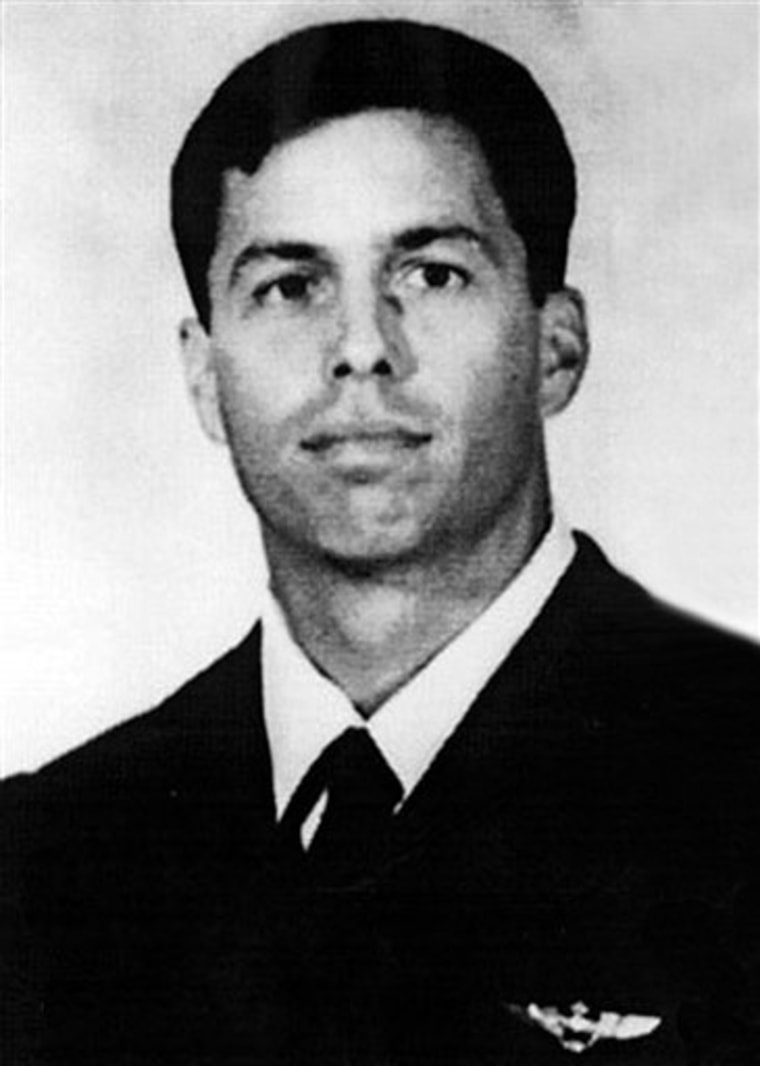Navy pilot Capt. Michael "Scott" Speicher was shot down over the Iraq desert on the first night of the Gulf War in 1991 and it was there Bedouins apparently buried him, hidden in the sand from the world's mightiest military all these years.
In a resolution to the nearly two-decade-old question about his fate, the Pentagon disclosed Sunday it had received new information last month from an Iraqi citizen that led Marines to recover bones and skeletal fragments — enough for a positive identification.
His family issued a statement Sunday saying, "The news that Captain Speicher has died on Iraqi soil after ejecting from his aircraft has been difficult for the family, but his actions in combat, and the search for him, will forever remain in their hearts and minds."
President Barack Obama called the news "a reminder of the selfless service that led him to make the ultimate sacrifice for our freedom."
"My thoughts and prayers are with his family, and I hope that the recovery of his remains will bring them a needed sense of closure," Obama said in a statement issued Sunday.
Former President George H.W. Bush, who was commander in chief in 1991, said, "We already knew he was a hero, one who helped lead our way to a historic victory in the Gulf, but now his family and countrymen know — and history will finally record — that he was one of the very first patriots to give his life in the liberation of Kuwait."
Shot down over west-central Iraq on a combat mission in his FA-18 Hornet on Jan. 17, 1991, Speicher was declared killed by the Pentagon hours later. Then-Defense Secretary Dick Cheney went on television and announced the U.S. had suffered its first casualty of the war.
But 10 years later, the Navy changed his status to missing in action, citing an absence of evidence that Speicher had died. In October 2002, the Navy switched his status to "missing/captured," although it has never said what evidence it had that he ever was in captivity. More reviews followed, without definitive answers.
'This whole thing has been so surreal'
The family Speicher left behind, from outside Jacksonville, Fla., continued to press for the military to do more. A high school classmates who helped form the group "Friends Working to Free Scott Speicher" said Sunday his biggest fear was that Speicher had been taken alive and tortured.

"This whole thing has been so surreal for all of the people who have known Scott," said Nels Jensen, 52, who now lives in Arkansas.
Over the years, critics contended the Navy had not done enough, particularly right after the crash, to search for the 33-year-old Speicher. A lieutenant commander when he went missing, Speicher later reached the rank of captain because he kept receiving promotions while his status was unknown.
Family spokeswoman Cindy Laquidara said relatives learned on Saturday that Speicher's remains had been found. "The family's proud of the way the Defense Department continued on with our request" to not abandon the search, she said. "We will be bringing him home."
Many new leads after ’03 invasion of Iraq
The U.S.-led invasion of Iraq in 2003 finally gave investigators the chance to search inside Iraq. Speicher's family — including two college-age children who were toddlers when he disappeared — believed more evidence would surface as Iraq grew more stable.
A number of new leads did come up, including the discovery of what some believed were the initials "MSS" scratched into the wall of an Iraqi prison. More than 50 sites were checked by military search crews in the months after the invasion — hospitals, prisons, security archives, homes and the original site where Speicher's plane crashed, about 100 miles (160 kilometers) north of the Saudi Arabian border.
Crews first visited the site in 1995. They found wings, the canopy and unexploded ordnance, but the cockpit and Speicher were missing.
Investigators excavated a potential grave site in Baghdad in 2005, tracked down Iraqis said to have information about Speicher and made numerous other inquiries.
Bedouins buried Speicher
Officials said Sunday that they got new information last month from an Iraqi citizen, prompting Marines stationed in the western province of Anbar to visit a location in the desert that was believed to be the crash site. The Iraqi said he knew of two other Iraqis who recalled an American jet crashing and the remains of the pilot being buried in the desert, the Pentagon said.
"One of these Iraqi citizens stated that they were present when Capt. Speicher was found dead at the crash site by Bedouins and his remains buried," the Defense Department said in a statement.
The military recovered bones and multiple skeletal fragments and Speicher was positively identified by matching a jawbone and dental records, said Rear Adm. Frank Thorp. He said the Iraqis told investigators that the Bedouins had buried Speicher. It was unclear whether the military had information on how soon Speicher died after the crash.
While dental records have confirmed the remains to be those of Speicher, Armed Forces Institute of Pathology in Rockville, Maryland, is running DNA tests on the remains recovered and comparing them with DNA reference samples previously provided by family members.
More on Michael "Scott" Speicher | Gulf War